2025 – The Southern Atlantic
In 2025, our scientific expeditions take us further into the Southern Atlantic Ocean, one of the least explored places on Earth. Scientists from all over the world will document biodiversity, study hazards such as earthquakes and volcanoes, and map seafloor features. Who knows what they will find? Follow our journey via video updates on our YouTube Channel and social media with each expedition’s hashtag — we are excited to take you with us as we boldly explore our unknown Ocean.
Climate Connections at the Ice-Sea Interface
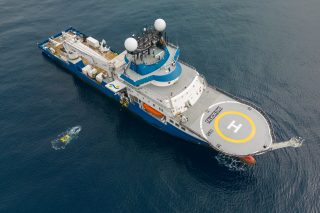 10 January – 13 February 2025
10 January – 13 February 2025
#AntarcticClimateConnections
In austral summer, the Antarctic ice sheet recedes, allowing scientists to map and study parts of the seafloor typically covered in ice, but the waters surrounding the Antarctic Peninsula in the Bellingshausen Sea have been minimally mapped and studied. Drs. Patricia Esquete from the University of Aveiro, Spain, and Alexsandr Montelli from the University of Cambridge, UK, will travel to this poorly charted region with their team of scientists to create the first high-resolution maps of this region and study the animals that dwell here.
Using these high-resolution maps along with ROV SuBastian the science team will advance research on ice-sheet melt dynamics, its impact on the Earth’s climate, and Antarctica’s biodiversity. They will also examine seafloor features carved by glaciers into the continental shelf over time and study the intricate ecosystems living at the interface between ice and sea. This research will provide critical insights into the stability of the Antarctic ice sheet, affiliated deep-sea ecosystems, and how these systems will be impacted by climate change.
Searching for New Species in the South Sandwich Islands
An Ocean Census Flagship Expedition
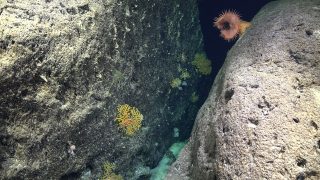 20 February – 28 March 2025
20 February – 28 March 2025
#SouthSandwichIslands
Sandwiched between South America’s Cape Horn and the Antarctic Peninsula is the Scotia Tectonic Plate. This small plate experiences tectonic forces that create an array of geologic features including hadal zone trenches, underwater volcanoes, and spreading centers. The South Georgia and South Sandwich Islands, two of the most remote island chains in the world, are located in the Southern Ocean. Seamounts, hydrothermal vents, and deep-sea trenches facilitate high levels of endemism, supporting species found nowhere else.
This Nippon Foundation-Nekton Ocean Census Flagship Expedition, led by Dr. Michelle Taylor, President of the Deep-Sea Biology Society, will locate and describe new species in this underexplored Ocean region. The data from this expedition will contribute to the Ocean Census mission to accelerate the discovery of ocean life. Dr. Jenny Gales leads GoSouth (a collaboration between the University of Plymouth, GEOMAR, and the British Antarctic Survey), which aims to survey volcanic flanks to determine the impacts of volcanism and earthquake activity on marine ecosystems and the generation of submarine geohazards— including landslides, tsunamis, and eruptions. The science team will seek out hydrothermal vents and deep-sea volcanoes and venture into the 8000-meter-deep South Sandwich Trench, the most geographically isolated and coldest trench on Earth.
Deep-Sea Expedition Leadership Master Class
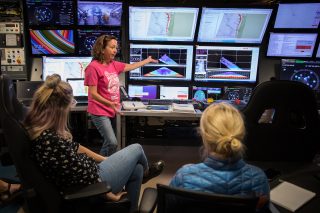 19 June – 26 June 2025
19 June – 26 June 2025
#DeepSeaLeaders
The advent and accessibility of deep-sea technologies created a renaissance in deep-water exploration and research. The efforts needed to coordinate and execute deep-sea scientific expeditions are not formally taught but are critical to a successful scientific expedition at sea. The Crustal Ocean Biosphere Research Accelerator, or COBRA, a program funded by the US National Science Foundation, currently runs a virtual deep-sea expedition leadership master class, bringing together scientists to learn these essential skills and to accelerate the readiness of the next generation of deepwater chief scientists.
Led by Drs. Julie Huber and Beth Orcutt, this cruise is offered to current and past COBRA Master Class Fellows, who will sail aboard the RV Falkor (too) to learn about the vessel’s capabilities. During a capstone training experience, participants will learn how to develop competitive proposals, design functional cruise and collaboration plans centered on the co-production of knowledge, and gain hands-on experience managing cruise data and day-by-day cruise planning. They will also improve their science communication skills, benefit from in-person mentoring with COBRA instructors, and work alongside Schmidt Ocean Institute’s crew and marine technicians.
Underwater Oases of Mar Del Plata Canyon
 23 July – 10 August 2025
23 July – 10 August 2025
#UnderwaterOases
Two powerful currents converge in the Mar del Plata Submarine Canyon in Argentina’s Exclusive Economic Zone. One is warm and salty; the other is nutrient-rich and cold. Together, they form the Brazil-Malvinas Confluence, one of the most energetic regions in our global Ocean. These currents help to redistribute heat from the tropics to the poles and play a prominent role in the Earth’s climate. They also support incredible submarine canyon ecosystems that have not yet been observed by scientists. This expedition will explore the diversity and distribution of seafloor communities in one of the country’s largest deep-sea canyons.
In 2012 and 2013, Argentinian scientists conducted the first expeditions in this region using fishing nets and trawls. With these low-tech tools, they discovered new species and published more than 60 papers. Their research allowed many students to launch their marine biology careers. Even without access to modern technology, this earlier expedition provided evidence of cold-water coral and sponge gardens that host abundant fish and invertebrates. Yet, their actual distribution and role in these ecosystems remains poorly understood. Using ROV SuBastian, the scientists will make the first in situ observations of this massive seafloor feature and document the biodiversity it harbors. This expedition — led by Dr. Daniel Lauretta of Museo Argentino de Ciencias Naturales Bernardino Rivadavia, Argentina — will establish a strong foundation for future research, conservation, and resource management.
Visualizing the Deep off Uruguay
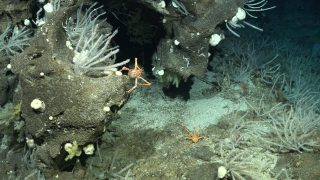 22 August – 19 September 2025
22 August – 19 September 2025
#DeepWaterUruguay
The Rio de la Plata drains into the Atlantic Ocean, delivering the sediment-rich contents of the Paraná and Uruguay Rivers, each fed by myriad streams and tributaries. The mixing of fresh water with the nutrient-rich seawater upwelled along the shelf fosters remarkable biodiversity, as well as tremendous pressure from overfishing. Vulnerable Marine Ecosystems, or VMEs, are critical habitats hosting sessile or stationary animals like corals and sponges. VMEs are home to many marine species and are vulnerable to human activities, such as fishing. Currently, there is only one reported VME in Uruguay that is home to cold-water coral reefs formed along the shelf break and slope by Desmophyllum pertusum, a species of coral that grows throughout the Atlantic. Scientists suspect there are more VMEs but have — until now — lacked access to the technology needed to describe deep-water ecosystems in Uruguayan waters.
The goal of this expedition is to characterize biodiversity along the country’s continental shelf. At the helm will be an international science team led by Dr. Alvar Carranza from the Departamento de Ecología y Gestión Ambiental Centro Universitario Regional del Este, part of the Universidad de la República of Uruguay. In addition to coral gardens and associated animals, scientists expect to encounter cold seeps and chemosynthetic communities. This expedition represents the first effort to systematically collect samples and footage from benthic communities in the deep waters offshore of Uruguay, providing data that will help decision-makers determine where to establish new marine protected areas.
A Tale of Two Submarine Canyons
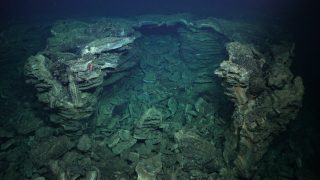 30 September – 29 October 2025
30 September – 29 October 2025
#Taleof2Canyons
The Malvinas Current offshore Argentina carries nutrients and cold water from Antarctica, boosting primary productivity in the Southwest Atlantic. Underwater canyons along Argentina’s Patagonia Shelf create irregularities in the seafloor that change the movement of this powerful current, facilitating an exchange between land and the open ocean. Scientists hypothesize this dynamic movement into the canyons fosters massive phytoplankton blooms and creates biodiversity hotspots in Argentina’s waters. However, these canyons have been poorly mapped, and the relationship between their shape, water movement, sedimentary processes, and biodiversity is not fully understood.
Principal investigator Dr. Silvia Romero, from Argentina’s Servicio de Hidrografía Naval, Universidad de la Defensa Nacional, and Universidad de Buenos Aires, along with her team, will map and study two underwater canyons along the Patagonia Shelf. They will compare and contrast how the different shapes of the canyons alter the movement of water masses using R/V Falkor (too)’s mapping technology, CTD & Rosette, and sensor suite, alongside imagery from ROV SuBastian. The team will study how the current interacts with each canyon’s individual topography to improve their understanding of these dynamic environments.
Searching for the Asgards
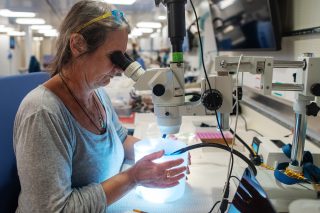 11 November – December 3 2025
11 November – December 3 2025
#AsgardArchaea
Almost all visible life on Earth is eukaryotic. Trees, fish, humans, kelp, flowers, mushrooms, and pygmy hippos all share one thing: they are built from multiple cells. These cells contain the nucleus and mitochondria, the powerhouses facilitating eating, breathing, sleeping, swimming, and physical appearance. Yet, where and how the first eukaryote came into existence is still one of biology’s greatest mysteries. Dr. Brett Baker of the University of Austin, Texas, and an international team are working to solve this mystery.
These scientists study the Asgard, a lineage of Archaea, which are single-celled microbes. Studies on Asgard Archaea reveal that, interestingly, they are the microbes most genetically related to multicellular life, making them possibly the first unicellular organisms that underwent eukaryogensis— the hypothesized process in which a bacteria and an archaea combined to create the first complex cell. They will search for a specific type of Asgard Archaea, Hodarchaeales, that thrives in coastal mud where fresh and saltwater mix. Their search takes them to the waters offshore of Uruguay and the mouth of the Rio de la Plata River. By collecting water and sediment samples and creating a genomic library, they will search for the answer to how complex life came to exist.
Life in Extremes — Cold Seeps of Argentina
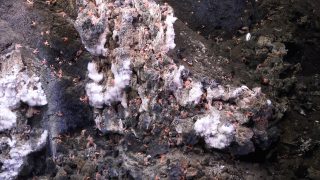 14 December 2025 – 10 January 2026
14 December 2025 – 10 January 2026
#ArgentinianDeepSeeps
Methane and hydrogen escape through cracks in the ocean floor, creating ephemeral landscapes that support an ecosystem adapted to survive on chemical — or chemosynthetic — reactions. Yet, only a fraction of the gas that escapes seeps makes it to the surface because the methane is readily consumed by microbes and animals, sustaining remarkable chemosynthetic communities.
Led by Dr. María Emilia Bravo from the National Scientific and Technical Research Council, or CONICET, Argentina, this international science team, which also includes members from Argentina’s universities and museums, has a primary goal to discover new cold seeps while exploring understudied benthic communities in the deep waters offshore of Argentina. Using an interdisciplinary approach, they will characterize biodiversity and habitats, assessing how microbial communities and animals live and reproduce in these extreme ecosystems. They will also examine the amount and type of microplastics in the chemosynthetic habitats they encounter. Data collected during this expedition will establish a baseline for managing resources and fisheries and monitoring the impacts of climate change.
